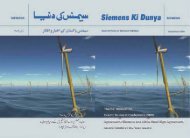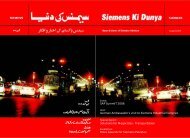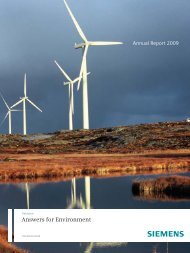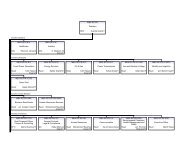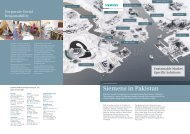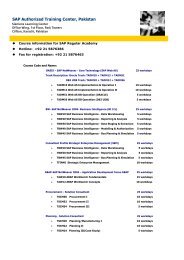Mohsin Annual Report-Final 1-91:Layout 1.qxd - Siemens Pakistan
Mohsin Annual Report-Final 1-91:Layout 1.qxd - Siemens Pakistan
Mohsin Annual Report-Final 1-91:Layout 1.qxd - Siemens Pakistan
You also want an ePaper? Increase the reach of your titles
YUMPU automatically turns print PDFs into web optimized ePapers that Google loves.
106Notes to the Financial Statements3.14 Foreign currenciesForeign currency transactions are translated into Pak Rupees at exchange rates prevailing on the date of transaction. Assets and liabilities(monetary items) in foreign currencies are translated at the rates of exchange prevailing at the balance sheet date. Exchange gains and losses areincluded in income currently.3.15 Revenue recognitionRevenue from sale of goods are recognised when significant risks and rewards of ownership are transferred to the buyer i.e., when deliveries aremade or when goods are specifically contractually appropriated. Service revenue is recognised over the contractual period or as and when servicesare rendered to customers. Commission income is recognised on receipt of credit note. Financial income is recognised as it accrues, using theeffective mark-up rates.Contract revenue and contract costs relating to long-term construction contracts are recognised as revenue and expenses respectively by referenceto stage of completion of contract activity at the balance sheet date. Stage of completion of a contract is determined by applying ‘cost-to-costmethod’. Under cost-to-cost method stage of completion of a contract is determined by reference to the proportion that contract cost incurred todate bears to the total estimated contract cost. Contract revenue on construction contracts valuing less than Rs 10 million and duration upto sixmonths is recognised using completed contract method. Expected losses on contracts are recognised as an expense immediately.In respect of certain sales contracts, the price differentials are accounted for in the year in which they are finally determined.3.16 Financial assets and liabilitiesAll financial assets and liabilities are initially measured at cost, which is the fair value of the consideration given or received as appropriate. Thesefinancial assets and liabilities are subsequently measured at fair value or amortised cost as the case may be. The Company derecognises thefinancial assets and financial liabilities when it ceases to be a party to such contractual provisions of the instruments.3.17 Derivative financial instrumentsThe Company uses derivative financial instruments to hedge its exposure to foreign exchange arising from operational activities. Any gain or lossfrom re-measuring the hedging instrument at fair value is recognised in the profit and loss account.3.18 DividendsDividend is recognised as a liability in the period in which it is declared.3.19 Share based payment transactionsThe fair value of the amount payable to employees in respect of share appreciation rights and / or phantom stocks, which are settled in cash, isrecognised as an expense, with a corresponding increase in liabilities, over the period that the employees become unconditionally entitled topayment. The liability is remeasured at each reporting date and at settlement date. Any changes in the fair value of the liability are recognised assalaries, wages and employment welfare expense in the profit and loss account.3.20 Discontinued operationsA discontinued operation is a component of the Company's business that represents a separate major line of business or geographical area ofoperations that has been disposed of or is held for sale. Classification as a discontinued operation occurs on disposal or when the operation meetsthe criteria to be classified as held for sale, if earlier. When an operation is classified as a discontinued operation, the comparative profit and lossaccount is restated as if the operation had been discontinued from the start of the comparative period.Non-current assets (or disposal groups comprising assets and liabilities) that are expected to be recovered primarily through sale rather thanthrough continuing use are classified as held for sale. Immediately before classification as held for sale, the assets (or components of a disposalgroup) are remeasured in accordance with the Company’s accounting policies. Thereafter generally the assets (or disposal group) are measured atthe lower of their carrying amount and fair value less cost to sell. Any impairment loss on a disposal group first is allocated to goodwill, and thento remaining assets and liabilities on pro rata basis, except that no loss is allocated to inventories, financial assets, deferred tax assets, employeebenefit assets, investment property and biological assets, which continue to be measured in accordance with the Company’s accounting policies.Impairment losses on initial classification as held for sale and subsequent gains or losses on remeasurement are recognised in profit or loss. Gainsare not recognised in excess of any cumulative impairment loss.3.21 Business combinationsBusiness combinations are accounted for by applying the purchase method. The cost of acquisition is measured as the fair value of the asset given,equity instruments issued and the liabilities incurred or assumed at the date of exchange, plus costs directly attributable to the acquisition.Identified assets acquired are recognised at fair value at the acquisition date, irrespective of the extent of any minority interest. The excess of costof acquisition over the fair value of identifiable net assets acquired is recorded as goodwill.Business combinations arising from transfer of interest in entities that are under the control of the shareholders that control both the companiesare accounted for as if the acquisition had occurred at the beginning of the earliest period presented or, if later, at the date such common controlwas established. For this purpose comparatives are restated. The assets and liabilities acquired are recognised at the fair values recognisedpreviously in the Group's consolidated financial statements.



